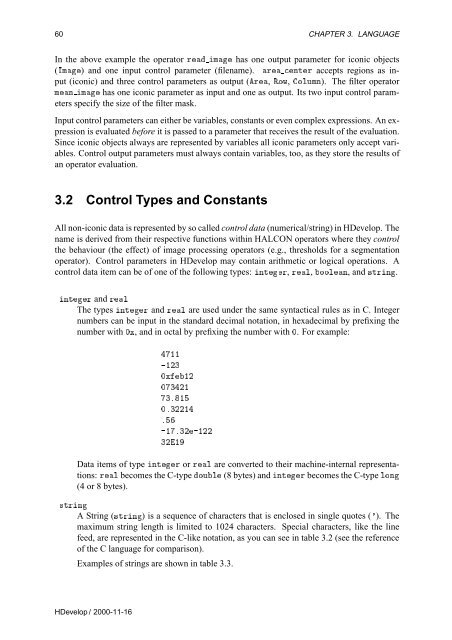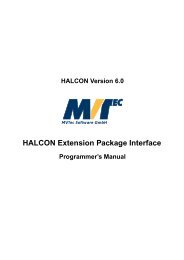Create successful ePaper yourself
Turn your PDF publications into a flip-book with our unique Google optimized e-Paper software.
60 CHAPTER 3. LANGUAGE<br />
In the above example the operator Ö Ñ has one output parameter for iconic objects<br />
(ÁÑ) and one input control parameter (filename). Ö ÒØÖ accepts regions as input<br />
(iconic) and three control parameters as output (Ö, ÊÓÛ, ÓÐÙÑÒ). The filter operator<br />
ÑÒ Ñ has one iconic parameter as input and one as output. Its two input control parameters<br />
specify the size of the filter mask.<br />
Input control parameters can either be variables, constants or even complex expressions. An expression<br />
is evaluated before it is passed to a parameter that receives the result of the evaluation.<br />
Since iconic objects always are represented by variables all iconic parameters only accept variables.<br />
Control output parameters must always contain variables, too, as they store the results of<br />
an operator evaluation.<br />
3.2 Control Types and Constants<br />
All non-iconic data is represented by so called control data (numerical/string) in <strong>HDevelop</strong>. The<br />
name is derived from their respective functions within HALCON operators where they control<br />
the behaviour (the effect) of image processing operators (e.g., thresholds for a segmentation<br />
operator). Control parameters in <strong>HDevelop</strong> may contain arithmetic or logical operations. A<br />
control data item can be of one of the following types: ÒØÖ, ÖÐ, ÓÓÐÒ, and×ØÖÒ.<br />
ÒØÖ and ÖÐ<br />
The types ÒØÖ and ÖÐ are used under the same syntactical rules as in C. Integer<br />
numbers can be input in the standard decimal notation, in hexadecimal by prefixing the<br />
number with ¼Ü, and in octal by prefixing the number with ¼. For example:<br />
½½<br />
¹½¾¿<br />
¼Ü½¾<br />
¼¿¾½<br />
¿º½<br />
¼º¿¾¾½<br />
º<br />
¹½º¿¾¹½¾¾<br />
¿¾½<br />
Data items of type ÒØÖ or ÖÐ are converted to their machine-internal representations:<br />
ÖÐ becomes the C-type ÓÙÐ (8 bytes) and ÒØÖ becomes the C-type ÐÓÒ<br />
(4 or 8 bytes).<br />
×ØÖÒ<br />
A String (×ØÖÒ) is a sequence of characters that is enclosed in single quotes (³). The<br />
maximum string length is limited to 1024 characters. Special characters, like the line<br />
feed, are represented in the C-like notation, as you can see in table 3.2 (see the reference<br />
of the C language for comparison).<br />
Examples of strings are shown in table 3.3.<br />
<strong>HDevelop</strong> / 2000-11-16
















